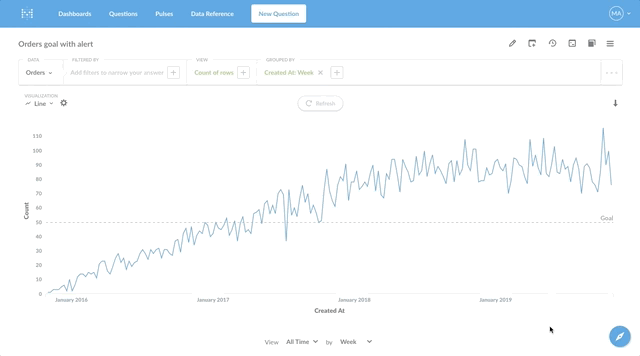

Using Metabase’s Sample Database, let’s say we wanted to know the average price of our products, grouped by product category. STDEV() – Calculates the standard deviation of values in a field. SUM() – Returns the sum of values in a field. MAX() – Identifies the maximum value in a field. MIN() – Identifies the minimum value in a field. Summary tables can be especially useful when working with large datasets since summary tables are precomputed, queries that rely on them can run much faster.ĭifferent databases have different sets of functions, but here are some of the most common aggregate functions that you’ll encounter:ĬOUNT() - Counts the number of rows in a table.ĪVG() – Computes the average of values in a field. Aggregation is the process of collapsing those values into a single result, and is usually performed in conjunction with grouping - that is, combining multiple rows based on a certain value, like grouping by a dimension (e.g., a product category or country).Īggregations can be calculated on the fly, but you may also want to create summary tables with your results and save the results of those aggregate functions for future use. Individual values in a field may not hold much meaning on their own, but when we combine these values in some specific way, we can paint a more comprehensive picture of our data. The resulting number is often called a metric, which is distinct from metrics in Metabase. “We are continuing to create new features and improve performance and overall experience in efforts to create the BI system of the future.The act of summarizing data with a mathematical function, such as a averaging the values in a column, or counting the number of rows in a table.Īn aggregation is the act of summarizing data with a mathematical function, such as averaging the values in a column, or counting the number of rows in a table. “Open source has changed from floppy disks to projects on the cloud, and we think end users have the right to see what they are running,” Al-Sakran said.
#METABASE SERIES INSIGHT HOW TO#
Due to Metabase often being someone’s first business intelligence tool, he is also doubling down on resources to help educate customers on how to ask questions and learn from their data. The new funding round enables the company to build out a sales team and continue with product development on both Metabase Enterprise and Metabase Cloud. The company pursued another round of funding after building out a commercial offering, Metabase Enterprise, that is doing well, Al-Sakran said. To date, Metabase has been downloaded 98 million times and used by more than 30,000 companies across 200 countries. This generation of open source is a better and greater example of all three of those.” “In addition, the world has moved to the cloud, and BI tools need to move there, too. “The third generation is here and they are leading the charge to insights and value,” Mathew added. George Mathew, managing director of Insight Partners, believes we are seeing the third generation of business intelligence tools emerging following centralized enterprise architectures like SAP, then self-service tools like Tableau and Looker and now companies like Metabase that can get users to discovery and insights quickly.

#METABASE SERIES INSIGHT SOFTWARE#
Increasingly, open source is the way software and information wants to be consumed, especially for the person that just wants to pull the data themselves, he added. He notes that not much has changed in the business intelligence realm since Tableau came out more than 15 years ago, and that computers can do more for the end user, particularly to understand what the user is going to do. “We provide a self-service access layer where they can ask a question, Metabase scans the data and they can use the results to build models, create a dashboard and even slice the data in ways they choose without having an analyst build out the database.” “When someone wants access to data, they may not know what to measure or how to use it, all they know is they have the data,” Al-Sakran said. Metabase was developed within venture studio Expa and spun out as an easy way for people to interact with data sets, co-founder and CEO Sameer Al-Sakran told TechCrunch. Metabase previously raised $8 million in Series A funding back in 2019, led by NEA. Open-source business intelligence company Metabase announced Thursday a $30 million Series B round led by Insight Partners.Įxisting investors Expa and NEA joined in on the round, which gives the San Francisco-based company a total of $42.5 million in funding since it was founded in 2015.


 0 kommentar(er)
0 kommentar(er)
